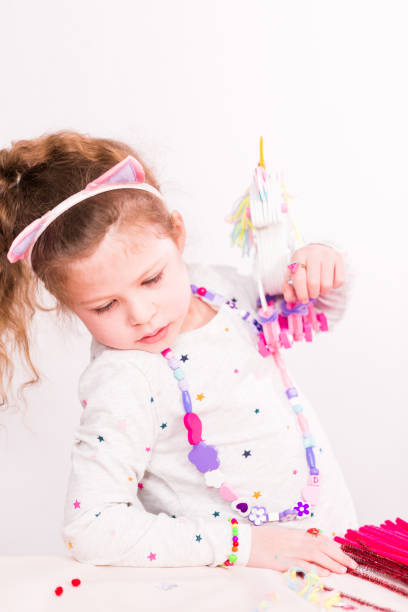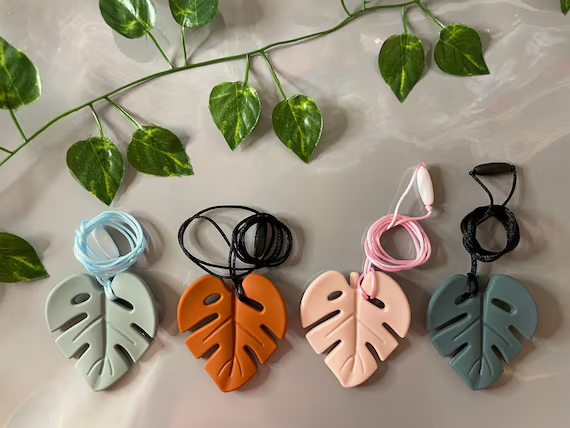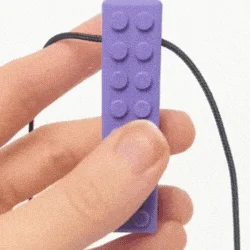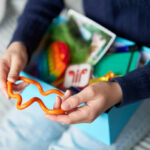For parents dealing with sensory processing challenges or teething troubles, finding a discreet, safe, and effective tool can be life-changing. One such discreet, yet powerful accessory is the chew necklace, which has become a game-changer for parents dealing with children’s sensory-seeking behaviors and teething discomfort. More than simple accessories, these innovative tools—often referred to as chew necklaces, sensory chew necklaces, or chewable necklace sensory products—provide practical relief and emotional balance in a chaotic world. They also offer a safe, stylish, and effective way to meet oral sensory needs and teething pain.
Designed for sensory and teething children, chew necklaces are a must-have for families, educators, and therapists, as they are both practical and useful. Explore the science behind children’s chew necklaces, their versatility, and community-driven insights with this guide, highlighting their benefits in sensory regulation and teething relief, including options like sensory chew necklaces for babies who love to nibble.
Chew Necklace Basics: A Multitool for Oral Sensory Regulation
Chewable necklaces, also known as sensory chew necklaces, are made from non-toxic, food-grade silicone or similar safe materials and are designed for children who need oral stimulation. Chew necklaces play an important role in relieving anxiety, reducing meltdowns, or simply satisfying sensory seeking behaviors..
Why Do Kids Chew?
Many parents on forums like Reddit’s r/Autism_Parenting or Quora’s special needs support threads have asked:
“Why does my child chew everything, even when they’re not teething?”
The answer lies in sensory needs. Children with Autism Spectrum Disorder (ASD), ADHD, or Sensory Processing Disorder (SPD) often seek proprioceptive or oral input as a way to self-regulate. Chewing mimics calming reflexes and can help ground them when they feel overstimulated.
🔍 Example:
A parent on Quora shared how their 7-year-old nonverbal autistic son found comfort chewing his hoodie strings. Once replaced with a chew necklace for kids, meltdowns decreased and communication therapy became more productive.

The Unique Role Of Sensory Chew Necklaces For Children
Unlike general fidget tools, chewy necklaces offer a direct form of oral-motor engagement that is both discreet and wearable. This is especially valuable in schools where traditional chew toys may not be allowed.
Key Features That Set Sensory Chew Necklaces Apart:
- Tactile textures to suit different preferences (smooth, bumpy, ridged)
- Adjustable lanyards for comfort and safety (often with breakaway clasps)
- Discreet design to avoid drawing attention
- Durability for aggressive chewers
🧠 Scientific Insight:
A 2019 occupational therapy study in The American Journal of Occupational Therapy indicated that consistent use of oral sensory tools like chew necklaces reduced classroom anxiety and improved concentration among students with SPD.
Transcendent Benefits: Sensory and Teething Chew Necklaces
Chew necklaces do more than redirect chewing—they foster emotional and developmental growth. By providing a safe outlet for sensory-seeking behaviors, they help children focus, reduce anxiety, and develop self-regulation skills. For teething kids, they offer pain relief without the risks associated with medications or unsafe objects.
Enhancing Focus and Emotional Regulation
Research supports that chewing can improve attention and reduce stress, particularly for children with autism or ADHD. A Reddit user shared how their 9-year-old’s sensory chew necklace reduced classroom disruptions by providing a discreet way to self-regulate. Therapists often incorporate chew necklaces into sensory diets, pairing them with activities like blowing bubbles or sucking thick liquids to stimulate the vagus nerve further.
Supporting Dental Health
Chewing on random objects like pencils or clothing can damage teeth and gums. Chew necklaces for teething kids and sensory seekers are designed to be gentle on oral tissues, reducing the risk of dental issues compared to nail-biting or chewing on hard plastics, as noted by a parent whose child transitioned from pencil erasers to gum after using a chew necklace.
Teething Chew Necklaces: More Than Just Baby Jewelry
It’s common to associate teething with infants, but toddlers and even preschool-aged children can experience discomfort as molars emerge. A chew necklace for teething kids offers a hygienic and always-accessible alternative to chewing on random items or fingers.
What Makes a Good Teething Chew Necklace?
- Soft, pliable silicone that massages sore gums
- Easy-to-clean surfaces
- BPA-free, phthalate-free materials
- Larger, rounded shapes to avoid choking hazards
💬 Community Insight:
In parenting Facebook groups, some caregivers describe how chew necklaces helped their teething toddlers avoid chewing on unsafe objects like phone cords or wooden toys.
When and How to Introduce Chew Necklaces into Everyday Life Tips
Introducing a chew necklace should be a thoughtful process, especially if the child is nonverbal or has complex needs.
Tips for Successful Introduction:
- Involve the child in choosing the design or color
- Explain or model its use
- Offer it during known stressful situations (e.g., transitions, public outings)
- Reinforce with positive feedback
To maximize the benefits of chew necklaces for kids, parents and caregivers can follow these community-tested strategies:
- Involve the Child in Selection: Let kids choose a design or color they love to increase acceptance. A Reddit parent found success by letting their 6-year-old pick a Lego-shaped chew necklace, making it a “cool” accessory.
- Establish Hygiene Rules: Regularly clean chew necklaces with soap and water or a dishwasher (if specified by the manufacturer) to maintain hygiene, as advised in parenting forums.
- Gradual Introduction: For children resistant to new tools, start by introducing the necklace during calm moments, gradually redirecting chewing behaviors, as suggested by an occupational therapist.
🔄 Real-Life Story:
A Reddit user detailed how their child with ADHD resisted using a sensory chew necklace until they found one shaped like a Lego brick—suddenly it became a favorite school accessory!
Addressing Aggressive Chewing: Choosing the Right Strength
Not all chewable necklaces are made equal. For children who chew forcefully, a standard necklace may wear out quickly or pose a hazard. That’s where sensory chew necklaces for aggressive chewers come in.
What to Look for:
- High-durometer silicone (stronger but still flexible)
- Reinforced cord and clasp
- Designs tested for safety under high-pressure chewing
🧩 Example:
Occupational therapists often recommend the “Brick Stick” or “Shark Tooth” models for aggressive chewers due to their dense textures and tested resistance. These options combine functionality with sensory input in a safe format.
Choosing the Perfect Chew Necklace: What to Check for Sensory and Teething Needs
Not all chew necklaces are created equal. The market offers a variety of designs, materials, and toughness levels to suit different chewing intensities and preferences. Whether you’re seeking a chew necklace for kids with sensory needs or a chew necklace for teething kids, understanding the options ensures you find the right fit.
| Aspect | Details |
|---|---|
| Purpose | Chew necklaces cater to sensory-seeking kids and teething toddlers, addressing oral sensory needs and teething pain. |
| Material Safety | Made from medical-grade silicone, free of BPA, phthalates, and lead. Brands like ARK Therapeutic and Munchables ensure safety. |
| Durability Options | ARK offers tiered toughness levels for aggressive chewers; softer silicone for teething toddlers. |
| Design and Discretion | Discreet designs resembling jewelry for older kids/adults; playful shapes for toddlers with breakaway clasps for safety. |
| Community Insight | Discussions emphasized low-profile design to avoid appearing childish and address concerns about social acceptance. |
🧠Addressing Safety: Reducing Stigma, Getting It Right
Concerns about the safety of chew necklaces, especially for young children, are a hot topic on parenting forums. The American Academy of Pediatrics (AAP) warns against wearing jewelry on infants due to the risk of choking, but this applies primarily to non-chewable items, and modern children’s chew necklaces are designed with safety in mind, with removable clasps and durable materials to minimize the risk.
Debunking Choking Myths
There is a common concern that children may chew on items and cause choking. However, high-quality chew necklaces are rigorously tested to ensure they will not break under normal use. For sensory chew necklaces designed for chewing children, brands such as ARK and Munchables use reinforced silicone to withstand vigorous chewing, reducing the risk of breakage.
Alternatives To Chew Necklaces
While chew necklaces are effective, some parents are exploring other alternatives, such as silicone bracelets or chewable pencil leads for use in school settings. These options provide similar sensory input but may be less conspicuous, addressing concerns about social stigma.But remember when choosing other chew tool options, be sure to consider the three important areas these human chew toys support: sensory, stress, and special needs.

A Small Tool With Big Potential
A chew necklace isn’t just about chewing—it’s about giving children control over their bodies, emotions, and comfort in a world that often overwhelms them. Whether used by sensory kids, teething toddlers, or aggressive chewers, these wearable tools offer safety, peace, and self-regulation.In a space full of gadgets and solutions, chew necklaces stand out because they blend function with empathy—and sometimes, that’s exactly what a child needs most.
The Future of Chew Necklaces: Innovation and Inclusion
The chew necklace market is evolving, with brands exploring eco-friendly materials and designs that cater to a broader age range, including adults. Online communities are pushing for more inclusive marketing, criticizing gendered designs and advocating for universal options that don’t alienate users. Innovations like vibrating chew tools offer additional sensory input, blending oral stimulation with tactile feedback for enhanced regulation.
Explore further:
- American Occupational Therapy Association (AOTA) – For evidence-based resources on sensory tools
- Sensory Processing Disorder Foundation – For community support and updated research



